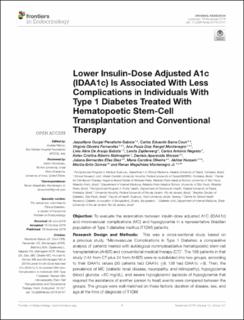Lower insulin-dose adjusted A1c (IDAA1c) is associated with less complications in Individuals with Type 1 Diabetes treated with hematopoetic stem-cell transplantation and conventional therapy
Penaforte-Saboia, Jaquellyne G; Couri, Carlos Eduardo Barra; Fernandes, Virginia Oliveira; Montenegro, Ana Paula Dias Rangel; Batista, Livia Aline De Araujo; Zajdenverg, Lenita; Negrato, Carlos Antonio; Malmegrim, Kelen Cristina Ribeiro; Moraes, Daniela Aparecida; Dias, Juliana Bernardes Elias; Oliveira, Maria Carolina; Hussain, Akhtar; Gomes, Marilia Brito; Montenegro, Renan Magalhaes
Peer reviewed, Journal article
Published version
Permanent lenke
https://hdl.handle.net/11250/2658637Utgivelsesdato
2019Metadata
Vis full innførselSamlinger
Originalversjon
Penaforte-Saboia, J. G., Couri, C. E. B., Fernandes, V. O., Montenegro, A. P. D. R., Batista, L. A. D. A., Zajdenverg, L., Negrato, C. A., Malmegrim, K. C. R., Moraes, D. A., Dias, J. B. E., Oliveira, M. C., Hussain, A., Gomes, M. B. & Montenegro Jr., R. M. (2019). Lower insulin-dose adjusted A1c (IDAA1c) is associated with less complications in Individuals with Type 1 Diabetes treated with hematopoetic stem-cell transplantation and conventional therapy. Frontiers in Endocrinology, 10: 747. doi: 10.3389/fendo.2019.00747Sammendrag
Objective: To evaluate the association between insulin-dose adjusted A1C (IDAA1c) and microvascular complications (MC) and hypoglycemia in a representative Brazilian population of Type 1 diabetes mellitus (T1DM) patients.
Research Design and Methods: This was a cross-sectional study based on a previous study, “Microvascular Complications in Type 1 Diabetes: a comparative analysis of patients treated with autologous nonmyeloablative hematopoietic stem-cell transplantation (AHST) and conventional medical therapy (CT)”. The 168 patients in that study (144 from CT plus 24 from AHST) were re-subdivided into two groups, according to their IDAA1c values (30 patients had IDAA1c ≤ 9; 138 had IDAA1c > 9). Then, the prevalence of MC (diabetic renal disease, neuropathy, and retinopathy), hypoglycemia (blood glucose <60 mg/dL), and severe hypoglycemic (episode of hypoglycemia that required the assistance of another person to treat) events were compared between the groups. The groups were well-matched on these factors: duration of disease, sex, and age at the time of diagnosis of T1DM.
Results: After an average of 8 years after diagnosis, only 6.6% (2/30) of the patients from IDAA1c ≤ 9 group developed any MC, whereas 21.0% (29/138) from the IDAA1c > 9 group had at least one complication (p = 0.044). Regarding hypoglycemic events, the proportion of individuals who reported at least 1 episode of hypoglycemia in the last month was 43.3 and 64.7% from the IDAA1c ≤ 9 and IDAA1c > 9 groups, respectively (p = 0.030). Regarding severe hypoglycemia, the proportion of patients presenting at least one episode in the last month and the rate of episode/patient/month were similar between groups (6.7 vs. 13.2%; p = 0.535; and 0.1/patient/month vs. 0.25/patient/month; p = 0.321).
Conclusion: In a representative Brazilian population of T1DM patients, those with IDAA1c ≤ 9 presented a lower frequency of MC, as well as fewer episodes of hypoglycemia, in the month prior to the analysis.

